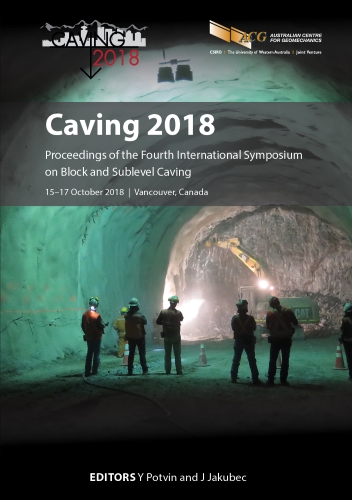Cave to mill: improving value of caving operations

|
Authors: Moss, A; Klein, B; Nadolski, S |
DOI https://doi.org/10.36487/ACG_rep/1815_06_Klein
Cite As:
Moss, A, Klein, B & Nadolski, S 2018, 'Cave to mill: improving value of caving operations', in Y Potvin & J Jakubec (eds), Caving 2018: Proceedings of the Fourth International Symposium on Block and Sublevel Caving, Australian Centre for Geomechanics, Perth, pp. 119-132, https://doi.org/10.36487/ACG_rep/1815_06_Klein
Abstract:
Forecasts indicate that there will be an increase in copper production from underground operations over the coming decades as available resources trend deeper. It is anticipated that a significant portion of this production will be from caving operations. Caving has a very different risk profile to open pit mining and other underground methods, with one of the critical areas being run-of-mine (ROM) grades that are delivered to the mill. Though caving can match pits in terms of operating cost per tonne, it suffers from limited grade selectivity with ROM grades trending toward the orebody average due to the consequences of mixing in cave columns. Research and subsequent operational trials have demonstrated that bulk sorting can manage this lack of selectivity by ‘pre-concentrating’ the ROM ore, providing the mill with a more consistent and higher grade feed. The paper describes the ‘cave to mill’ concept where the objective is to provide consistent feed (tonnes and grade) to the flotation circuit. This is done in three stages. The first stage is better characterisation of the material reporting to drawpoints. Secondly, measurement of the variation in metal content that is delivered from drawpoints through the use of scanners and sensors at various points in the ore flow system. Finally, bulk sorting systems offer flexibility and control by allowing classification of waste, low-grade and mill-grade streams in real time. The potential for bulk sorting is dependent on the heterogeneity of the ore and the ability of sensors to detect the heterogeneity. The broad technical requirements for each stage are discussed together with the associated business case.
Keywords: block cave mining, grade control, cave to mill, sensor-based sorting
References:
Albanese, T & McGagh, J 2011, ‘Future trends in mining’, in P Darling (ed.), SME Mining Engineering Handbook, 3rd edn, Society for Mining, Metallurgy and Exploration, Englewood.
Duffy, K, Valery, W, Jankovic, A & Holtham P 2015, ‘Integrating bulk ore sorting into a mining operation to maximise profitability’,
in D Pollard, G Dunlop & P Cameron (eds), Proceedings of MetPlant 2015: Metallurgical Plant Design and Operating Strategies - World's Best Practice, The Australasian Institute of Mining and Metallurgy, Melbourne.
Elshkaki, A, Graedel, TE, Barbara, LC & Reck, K 2016, ‘Copper demand, supply, and associated energy use to 2050’, Global Environmental Change, vol. 39, pp. 305–315.
Erdenebat, E 2017, Study of New Afton Ore Heterogeneity and its Amenability to Sensor Based Ore Sorting, MSc thesis, The University of British Columbia, Vancouver.
Gy, P 1995, ‘Introduction to the theory of sampling I. Heterogeneity of a population of uncorrelated units’, Trends in Analytical Chemistry, vol. 14, no. 2, pp. 67–76.
Hengemuhle, I, Klein, B & Bamber, A 2017, Pilot Study of MineSense Shovel Sensing System for a Low Grade Copper Ore, Engineering report, The University of British Columbia, Vancouver.
Klein, B & Bamber, B 2018, ‘Mineral sorting’, SME Mineral Processing & Extractive Metallurgy Handbook, to be published.
Kurth H 2017, ‘Suitability of on-belt elemental analysis for real-time ore quality measurement and bulk sorting’, Proceedings of the 49th Conference of Metallurgists, Canadian Institute of Mining, Metallurgy and Petroleum, Westmount.
McKee, DJ, Chitombo, GP & Morrell, S 1995, ‘The relationship between fragmentation in mining and comminution circuit throughput’, Minerals Engineering, vol. 8, no. 11, pp. 1265–1274,
Nadolski, S, Klein, B, Elmo, D & Scoble, M 2015, ‘Cave-to-Mill: a Mine-to-Mill approach for block cave mines’, Mining Technology, vol. 124, no. 1, pp. 47–55.
Nadolski, S, Klein, B, Elmo, D, Scoble, M, Liu, Y & Scholar, J 2016, ‘Investigation into the implementation of sensor-based ore sorting systems at a block caving operation’, Proceedings of MassMin 2016, The Australasian Institute of Mining and Metallurgy, Melbourne, pp. 393–399.
Nadolski, S, Samuels, M, Klein, B & Hart, C 2017, ‘Evaluation of bulk and particle sensor-based sorting systems for the New Afton block caving operation’, Minerals Engineering, vol. 121, pp. 169–179.
Peele, R 1918, Mining Engineers’ Handbook, 1st Edition, John Wiley & Sons Inc, New York.
© Copyright 2025, Australian Centre for Geomechanics (ACG), The University of Western Australia. All rights reserved.
View copyright/legal information
Please direct any queries or error reports to repository-acg@uwa.edu.au
View copyright/legal information
Please direct any queries or error reports to repository-acg@uwa.edu.au
